People throughout the world wear many different styles of clothing and accessories, depending on the nation from which they hail and their social status. Styles range from the humble attire worn by Air Nomads to the elaborate robes worn by the Fire Lord. By the time the United Republic of Nations was founded, fashion began to diversify as new elements were incorporated into traditional designs.
A notable fact of fashion in general is that each nation wears the color that symbolizes their native element: The Air Nomads dress in orange and yellow; the people of the Water Tribe wear blue, purple, and white clothing; the people of the Earth Kingdom wear brown, yellow, and green attire; and the people of the Fire Nation wear various hues of red, brown, black, pink, and gold.[3]
Air Nomads[]
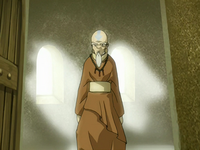
A nomadic monk sporting conventional robes.
The colors worn by the Air Nomads were browns, oranges, and saffron yellows, which is the general palette linked to airbending.[2][4]
Clothing[]
Air Nomad attire was as simple as the lifestyle of the people who wore it. Staples included an assortment of loose apparel, such as cloaks, robes, and shawls. Monks sometimes also wore a set of beads, depending on their position in the council. In general, Air Nomad clothing became more layered as a monk increased in position and improved in skill.[2]
Monk robes[]
Senior monks who had become master airbenders wore layered robes much longer than garments seen on children. The under-robes were designed with a yellow collar, while the flowing over-robes were brown and often belted with a sash. The armlets were loose and opened wide at the wrist.[2] Women of the same rank generally sported dresses fashioned in a similar style, but with a yellow lining that extended over the bust and met a long underskirt of the same yellow color.[5]
Necklaces[]
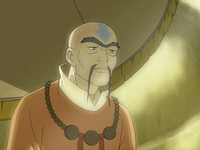
Monk Pasang, an elder of the Southern Air Temple during Aang's childhood, wore a typical Air Nomad necklace.
Senior monks wore necklaces made of wood, signifying their rank and superior skill. The necklaces usually consisted of wooden beads and a number of round, wooden disks carved with the Air Nomad emblem. Necklaces could also include small leather knots or tassels.[6]
After the conclusion of the Hundred Year War, Avatar Aang wore a similarly-fashioned wooden necklace but with four round disks, each bearing a different elemental symbol. To contact his past lives, he meditated on the disk bearing the previous Avatar's native element.[7]
Young Air Nomads[]
Young Air Nomads in training wore long-sleeved yellow shirts, loose orange shawls, brown pants, and tall red boots. The front of the shirt fell to the knees but was cut at the crotch to leave the material draping only over the outside of the legs. The shirt was held in place by an orange, belt-like wrap, and the end of the leg draping was tucked securely into the top of the knee-high boots. Both the leg draping and the shawls could act as a parachute, catching air as the young bender fell to slow their descent.[2]
Customs[]
Shaving[]
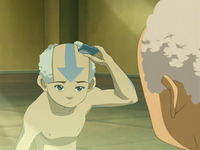
Aang used an Air Nomad shaving tool to remove the hair from his head per Air Nomad tradition.
Shaving one's head was a tradition in Air Nomad society. Both young nomads who were in training and master airbenders shaved their heads, while elders were permitted to grow beards and mustaches.[2] Female master Air Nomads shaved the front portion of their heads in order to reveal their tattooed arrow and identify themselves as nuns.[8] Air Nomads utilized shaving tools, with Aang possessing a curved, blue and white razor decorated with the symbol of the nomads.[9] Much like washing, shaving was considered part of the morning ritual to prepare for the day ahead.[10]
Shaving one's head was done for both practical and aesthetic reasons; having a shaved head allowed for increased sensitivity to surrounding air currents, which helped the Air Nomads to anticipate their opponent's movements and counterattack more effectively. According to Tenzin, shaving one's head was a personal choice.[11]
Tattoos[]
- Main article: Body markings in the World of Avatar
The arrow tattoos that run down an Air Nomad's chi paths signified their mastery of airbending. The design was an emulation of the natural arrows on the heads of flying bisons, the original airbenders and animals revered by the Air Nomads. Apprentice airbenders had no tattoos,[2] as they received their markings after passing the thirty-six levels of airbending, or slightly earlier if they create a new airbending technique. The attainment of these tattoos was revealed during a public ceremony.
The wearing of these tattoos was taken very seriously: When members of the Yu Dao chapter of the Avatar Aang Fan Club tattooed themselves in a similar matter, they intended it as an homage to Air Nomad culture. However, Aang himself saw the gesture as a great insult, as the tattoos were sacred to his people and had to be earned through rigorous dedication and training.[12]
Air Nation[]
As the cultural successors of the Air Nomads, the people of the Air Nation largely follow the same fashion trends as the extinct nation, though with some differences.
Air Acolytes[]
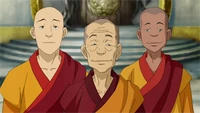
Air Acolytes wearing traditional Air Nomad clothes.
The outfits of the Air Nomads and Air Acolytes have stayed more or less the same as those traditionally worn by the Air Nomads, although the Air Acolytes wear fewer bright colors, reflecting their less prominent role in Air Nomad society. The young airbenders—Jinora, Ikki, and Meelo—wear clothing similar to that of the young Aang, while elder airbenders incorporate layers in their clothing, most noticeably the long capes which Tenzin and the elder Aang wear in addition to their shawls, and both are a vivid shade of scarlet.
Air Nomad formal wear[]
A new phenomenon in Air Nomad attire is the appearance of formal wear, which incorporates rich, lavish colors such as dark red and gold. At the gala held by Tarrlok in honor of Avatar Korra, Tenzin wore scarlet robes which covered the shoulders and legs and were open at the front to reveal the dark red and gold dress shirt he wore underneath, while Pema wore a dark red dress with a scarlet cape and shawl. The young airbenders wore similar attire to their everyday dress, only their orange shawls were replaced with a scarlet shawl and cape. Pema, Jinora, and Ikki had their hair specially arranged for the occasion: Pema wore her hair down, while the girls wore ribbons in their hair.[13]
Airbender wingsuits[]
- Main article: Airbender wingsuit
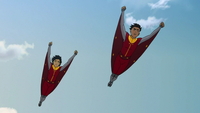
Wingsuits enable airbenders to easily soar through the sky without the use of a glider staff.
Sometime between 171 AG and 174 AG, Asami Sato designed and had Future Industries develop wingsuits that enable airbenders to fly without the need of an airbender staff.[14] With fabric attached to the legs and arms that flares open due to the wind, the airbender wearing the suit gains more maneuverability and aerodynamic movement, enabling the user to have greater control over their motions in the air. While unused, the wings are attached to the hips and torso with press snap buttons. If the fabric comprising the wings was torn or otherwise damaged, however, it significantly impacted flying capabilities, sometimes preventing them altogether.[15]
Water Tribe[]
The citizens of the Northern and Southern Water Tribe wear blues, purples, and whites as their general palette, representing the nation's cultural heritage and the practice of waterbending. The attire in both the polar tribes usually incorporates furs and thick material.[3]
Outer wear[]
Fur coats[]
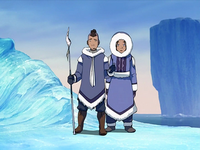
Water Tribe citizens such as Katara and Sokka wear heavy fur coats when out in the cold.
When out in the cold, people of the Water Tribes wear heavy, hooded coats, lined and trimmed with soft fur to keep the wearer warm. The exteriors often bear designs resembling waves or other imagery that link the garments to waterbending and the general culture of the Water Tribes.
These coats can be found in an array of styles; although not universal, women's coats are usually shown with a fur or leather belt-like wrap tied just below the chest, while men's coats typically have no tie at the waist and display string-like fur hangings suspended from the collar. In general, men's coats also tend to be shorter than those worn by women.[3] Coats worn by young children sometimes follow these aesthetics, but at other times consist of simple draped coverings that change little between the sexes.[16][17]
By Avatar Korra's lifetime, coats in the Southern Water Tribe had become more elaborate and diverse; while retaining the general aesthetic distinguishing men's and women's styles, the coats consisted of multiple interconnected components.[18]
Gloves[]
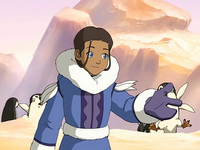
Gloves are commonly worn in the Water Tribe to protect against the cold.
Multiple styles of gloves can be found among the Water Tribes: The style worn by Katara, for example, has the index finger and thumb separate from the rest of the mitten. Another design is the classic five-fingered glove, such as those worn by Princess Yue.[19] Men in the Water Tribes usually wear a three-hole mitten, keeping their index and middle fingers separate from the ring and pinkie fingers, and the thumb by itself.
Light clothing[]
This type of clothing is worn beneath the fur coats, the latter of which are not often used when traveling to warmer regions. Women typically wear long, kimono-like tunics that extend to the knees or ankles, often with split sides for leg movement. Men's tunics are similarly fashioned but boxier and less form-fitting. They are also shorter, usually extending only to the waist or, at most, to the knees. These tunics can consist of multiple layers and, depending on the season and location in which they are worn, may be long-sleeved, short-sleeved, or have no sleeves at all. Fur-trimmed leggings or breeches, which can be close-fitting or baggy in style, are worn by both men and women.[20]
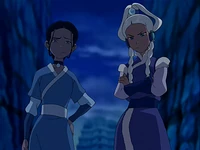
Lighter clothing is worn without coats when traveling to warmer regions.
Lighter clothing also comes in various styles: Princess Yue's lighter clothing is shown as a light purple dress covered by a kimono-like tunic in a darker shade of purple. Her attire also had no split sides, like those of Katara's and Sokka's. The tunic was lined with white trim, displaying the Water Tribe emblem in the lower corner.[21][22] This purple coloring seems to be something of a trend in the Northern Tribe, and at least more so than in the South, as Malina and Maliq were also seen wearing it during their time in the South Pole, though in a slightly lighter shade.[23] Katara's and Yue's dresses also somewhat resemble Vietnamese Ao Dai, a long, split tunic dress worn over trousers.
The lighter clothing worn by Avatar Korra, while unmistakably Water Tribe in style, is noticeably more masculine in its design; her tunics are often sleeveless and much shorter than those normally worn by women, and she typically eschews longer dresses and most ornaments, except during formal occasions.[24]
A kuspuk is a type of hooded overshirt worn by people of the Water Tribe. It is typically worn under outer clothing in cold climates, but can be worn without anything else while abroad.[25]
Undergarments[]
Sarashi[]
These strips of cloth are wrapped around the woman's hips and chest and worn as undergarments or even as a swimsuit.[26] Men can specially wrap a sarashi as a loincloth, worn in a similar fashion to briefs or boxers.[27] The sarashi can also be used to wrap injuries and can be wrapped around one's arms or legs to prevent sprains.
Hair[]

Hair loopies are a traditional style in the Water Tribe.
Hair loopies[]
- Main article: Hair loopies
Hair loopies are a traditional hairstyle worn by the women of the polar Water Tribes. Two locks of hair on either side of the head are fastened with clips onto the back of the head, hanging down more loosely than the rest of the hair. In the Southern Water Tribe, these loopies are usually plain, however, in the Northern Water Tribe, they are often braided into elaborate designs.
Warrior's wolf tail[]
- Main article: Warrior's wolf tail
A warrior's wolf tail is a hairstyle used by male Water Tribe warriors.[28] This style requires younger warriors, like Sokka, to shave the sides of their head, only growing the top. The hair is pulled back and tied in a short queue, resembling a wolf's tail. As the warrior gets older, the sides of his hair grow and remain uncut. The hair grows out with age, eventually reaching a length to the warrior's mid-back. Sokka and the rest of the Southern Water Tribe warriors sported this style during the invasion of the Fire Nation.
Headpieces[]
- Main article: Headpieces
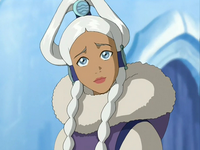
Princess Yue was one of the few members of the Water Tribe known to wear hair ornaments: she wore blue bands decorated with lighter blue medallions bearing the Water Tribe insignia, and they were used to hold up, tie, and decorate her hair.[19]
Other members of the Water Tribes generally wear a variety of hair ties, hats, and beads rather than full-on ornaments: Katara and other female tribe members, for example, used ties to hold their hairstyles in place and beads to decorate them;[20] Tarrlok wore his hair in three narrow queues decorated with small blue beads; and Avatar Korra wore a small, cup-like cap during formal occasions.[13]
Customs[]
Cosmetics[]
- Main article: Body markings in the World of Avatar
Water Tribe warriors wear face paint during battles,[22][29] allowing other warriors in the tribe to distinguish their own members as well as serve as a type of camouflage in the ice-filled tundra of the poles. In the Northern Water Tribe, women also employ cosmetics; Princess Yue, for example, wore makeup of various pink/peach shades on a regular basis,[21] and Eska wore subtle touches of purple eyeshadow when attending the Glacier Spirits Festival with her family.[30] Other members of the Water Tribe, such as Sifu Amak, wore bone piercings.[31]
Necklaces[]
- Main article: Betrothal necklace
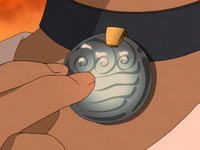
Katara's necklace was originally carved by Pakku for Kanna.
In the Water Tribes, it is traditional for a man to give a special necklace to the woman whom he wishes to marry. This betrothal necklace—often crafted by the prospective groom himself[19]—typically takes the form of a blue medallion on a choker, though there is no one standard design. The necklace signifies the engagement of the couple and indicates to other men that the woman is spoken for.[19]
Other Water Tribe necklaces serve purely aesthetic purposes, such as the chokers worn by Sokka and many other male tribesmen, often made of white material.[28]
Foggy Swamp Tribe[]
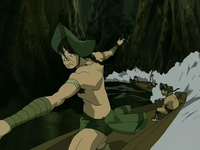
Like most male members of the Foggy Swamp Tribe, Due only wore a loincloth made of natural materials.
The members of the Foggy Swamp Tribe utilize natural materials from the swamp to craft their clothing and accessories, including leaves, tree bark, and possibly animal skins. These are fashioned into a variety of simple garments, including skirts, loincloths, hats made from single large leaves, and shirts. Men do not wear any upper body clothes or leg coverings, only the areas below the hip being covered with clothes and undergarments, while women wear both upper body clothes and skirts for their lower bodies. Due to the use of these natural elements, the people of the Foggy Swamp Tribe sport various greens and browns, rather than the blues and whites of their polar cousins.[32] It should be noted, though, that the water in the swamp is green due to the abundance of plant life, so the Foggy Swamp Tribe follows the consistent model for clothing of wearing the color of their element.
Men of the Foggy Swamp Tribe often wear their hair in long, braided queues, somewhat similar to men in the Upper Ring of Ba Sing Se.[32] The tribe also utilizes wood to create necklaces[32] and a crude form of wooden armor pieces, the latter of which was worn during the attempted invasion of the Fire Nation on the Day of Black Sun.[33]
Earth Kingdom[]
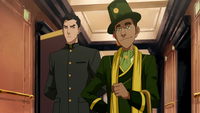
Earth King Wu was an avid fashion fan and enjoyed going to places such as the Little Ba Sing Se Fashion Mall.
A great diversity of clothing exists within the Earth Kingdom, reflecting its vast size and varied climates. Citizens typically dress in an array of greens, browns, golds, yellows, and other "earthy" colors;[20] Kyoshi Islanders, who usually dress in blue attire, are an exception.[34] Particular styles of clothing can indicate wealth, social status, and even local customs: In general, people residing in rural areas or from modest backgrounds, such as Haru and his family, wear relatively simple clothing, while royalty and other wealthy citizens, such as the residents of the Upper Ring of Ba Sing Se, usually wear fancier attire.[35]
Ba Sing Se[]
More than anywhere else in the Earth Kingdom, Ba Sing Se demonstrates how fashion can reflect social status. The city is divided into three different socioeconomic rings, each housing people of specific classes and backgrounds, so there are great variations in attire. Generally, however, lower class citizens wear darker colors, while the middle and higher classes wear lighter colors.[35]
Lower Ring[]
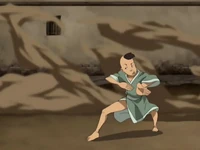
Citizens in the Lower Ring of Ba Sing Se wear very simple clothing.
The Lower Ring is the poorest, dirtiest, and most crime-ridden area of the city. People here tend to wear clothing in shades of brown and dark green, emphasizing their low position in society. The style of these clothes is anything but elaborate; most wear raggedy kimono-like tunics and, if lucky, a reasonable pair of shoes.[35]
Hair[]
Hair is not usually styled in the Lower Ring. Women tie their hair back or style it in some form of bun though not to an extravagant degree, and men almost universally wear queues. Some exceptions can be found, however, due to the large number of refugees from other parts of the Earth Kingdom that have settled in the Lower Ring.
Middle Ring[]

Iroh and Zuko dressed as citizens of Ba Sing Se.
In the Middle Ring, clothing is fashioned in more elaborate styles, usually in lighter shades of green. Women wear dresses accented with gold and yellow, and men sport more extravagant tunics.[35]
Hair[]
Middle-class families are adequately secure, financially. Therefore, men can afford to braid their hair or pull it back in a top-knot, often wrapped with a green band. Women too have more elaborate and decorated hairdos.[35]
Upper Ring[]
Due to the great wealth of the Upper Ring, its inhabitants wear the most extravagant styles of all. Their clothing is fashioned in various shades of light green with gold trimmings, worked into elaborate designs and patterns. Women wear full-length dresses, and men longer and more heavily embroidered tunics.[10]
Accessories and cosmetics[]
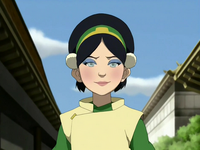
Toph wearing makeup from the Fancy Lady Day Spa in the Upper Ring.
Women in the Upper Ring are often seen with accessories, such as elaborate headpieces, often gold-colored and adorned with flowers,[35] dark green fans bordered with gold in a wooden frame, and chartreuse parasols made of a similar wood.[10] Higher class women also wear cosmetics, varying from applying white powder as foundation, to accentuating their cheeks with pink or red blush, and wearing variously colored eyeshadows.[10]
Hair[]
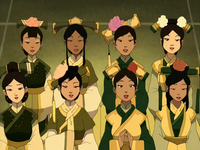
Women's clothing and hairdos in the Upper Ring are well represented by the members of the Five-Seven-Five Society.
Women in the Upper Ring typically sport an elaborate hairstyle known as a qitou. The hair is worn long, often with bangs, and collected in a bun at the base of the neck. Generally, the most noticeable feature of this hairstyle is the large hairpiece, the shape of which can range from thin and straight to broad and fan-shaped. This hairpiece is usually accessorized with beads, pins, tassels, and large fresh flowers. Men, as in the Lower Ring, almost universally wear a queue or long braid, and keep the front of their head shaved. A few exceptions do exist, however, as the generals on the Council of Five wear the more typical Earth Kingdom fashion of a top-knot and coronet.[10]
Earth Monarch[]
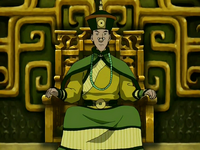
The Earth King in his traditional attire.
The Earth King wears a formal green and yellow robe known as a chaofu, with distinctive horse-hoof cuffs and a green ceremonial collar, known as a piling. On his head he wears a black hat with red trim, a gold finial on the top, and the Earth Kingdom symbol on the front. Around his waist he wears a green sash, fastened with a buckle shaped like the Earth Kingdom symbol. The ensemble is completed by a set of court beads fashioned from jade.[36] When visiting colder climates, King Kuei's attire stayed essentially the same but with more layers and a fur-lined cloak to protect against the cold.[23]
Earth Queen Hou-Ting wore a long yellow one piece skirt which had a green overcoat, as well as colorful and golden jewelry.
Outside Ba Sing Se[]
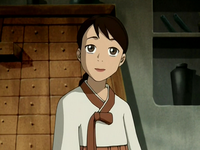
Outside of Ba Sing Se, clothing becomes much more varied. The general Earth Kingdom palette of greens, browns, and yellows still predominates, but styles can be significantly different from region to region. There are certain exceptions to this color palette, however: a group of singing nomads – Chong, Lily, and Moku – wore multicolored clothing in eccentric styles,[27] reflecting their carefree and non-conformist nature. Jet and his Freedom Fighters, due to their "off-the-grid" lifestyle, wore clothing that was cobbled together from a variety of sources, including discarded pieces of Fire Nation armor.
Depending on the location, social divisions may also be much less rigid than in Ba Sing Se, and clothing may not change significantly in style between people of different classes. Different kinds of clothing may also be adopted for specific tasks, regardless of the wearer's status.
Gan Jin tribe[]
The Gan Jin, although displaced during the Hundred Year War, pride themselves on their sophistication and refinement, which is reflected in their clothing; attire consists of long, elegant robes in shades of creamy white, pale yellow, and gold. Hair is well-maintained and often elaborately coiffed, and men sport elaborately styled beards. The style of clothing does not appear to change significantly between the sexes.[37]
Zhang tribe[]
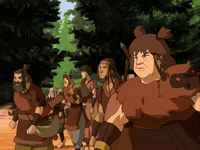
Zhang tribespeople predominantly wear crudely-made clothing.
The Zhang are known for their rough-and-ready lifestyle, which is reflected in their clothing. The tribe dresses predominantly in crudely-made clothing — usually in shades of reddish-brown, gray, and black — without any significant decoration. The leader of the tribe also wore a tunic made from the pelt of a hog monkey, with the creature's head serving as shoulder decoration.[37]
Gaoling[]
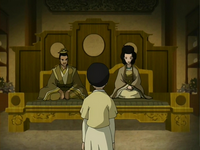
The clothing of the wealthy Beifong family reflected their high status.
As a large and prosperous town, Gaoling was home to a broad range of people of various classes. While remaining secluded on her parents' estate, Toph Beifong wore an elegant dress with a white skirt, yellow sleeves, and bodice decorated with a floral motif, while her parents, Lao and Poppy Beifong, wore long, flowing robes in shades of olive green.[38]
Makapu Village[]
The residents of Makapu Village wear an assortment of colors, mainly green and yellow, as well as blue, purple, and pink shades.[39]
Kyoshi Island[]
The Kyoshi Islanders are unusual in that they wear blue clothing, as opposed to the greens, yellows, and browns found in most of the Earth Kingdom. This started to become common in the early life of Avatar Kyoshi.[40] Because of its relative proximity to the South Pole, with an economy based largely on fishing and agriculture, clothing on the island tends to be multi-layered against the cold and fairly simple in design.[34]
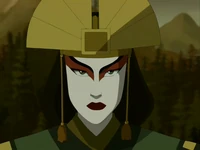
Kyoshi wore makeup that was later copied by her namesake warriors.
The major exception to this scheme is the Kyoshi Warriors, the island's famed corps of all-female fighters. Modeled after the island's creator and namesake protector, Avatar Kyoshi, these warriors clad themselves in armored green kimonos, metal headdresses, and elaborate makeup. The kimonos are embroidered with silk thread, representing the brave blood that flows through the warrior's veins, and bear a gold insignia representing the honor in their hearts.[34]
Omashu[]
As a large, cosmopolitan center—second in size and importance only to Ba Sing Se—Omashu contains many distinctive styles of clothing.
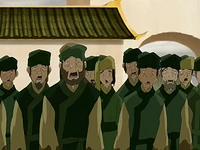
Members of the Omashu Resistance faked a pentapox epidemic to escape the Fire Nation-occupied city.
Earthbending soldiers, who guard the city gates and operate its famous internal delivery system, wear long yellow tunics over gray pants, accompanied by hats, shawls, and lower-leg protection in strong green. Studded gray gauntlets provide lower arm protection, and the tunics are secured with a belt whose buckle is shaped like the Earth Kingdom symbol. As with many earthbending soldiers, their feet are bare to create greater sensitivity with the earth. Non-bending soldiers wear longer, more layered tunics in shades of brown and olive green, the upper portion of which also bears the Earth Kingdom symbol, as well as heavy boots.[41]
Ordinary citizens appear to dress in fairly simple but well-made garments in shades of bright green and yellow, somewhat similar to the Middle Ring of Ba Sing Se, and some citizens also wear green turbans.[41] The clothing worn by the Omashu Resistance during the Fire Nation occupation was slightly more uniform in style but not completely homogeneous: An under layer—either a tunic and pants or a dress—in yellow or pale green, and a shorter, sleeveless over tunic in various shades of green, trimmed with a contrasting green stripe and belted with the left-hand lapel over the right.
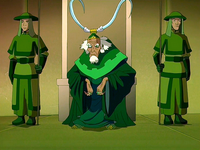
The Monarch of Omashu dresses in elaborate clothes similar to those of the Earth Monarch. The king usually sports a green hat, a green or purple robe, and several elaborate rings.[41]
Si Wong tribes[]
The Si Wong tribes wear tight and loose fitting clothes. Head wraps and goggles are worn on their heads to keep sand out of their eyes and hair. The popular colors of these tribes resemble the desert's colors, predominately tan and brown, although some people prefer a more traditional Earth Kingdom-green.[42]
Zaofu[]
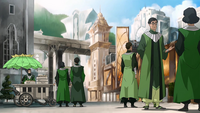
Clothing styles in Zaofu are more modern than seen elsewhere in the Earth Kingdom.
Zaofu prides itself on being a center of technological and cultural innovation, and the clothing of the Metal Clan reflects this, being essentially a modern update on traditional Earth Kingdom garb: Dominated by shades of green, gray, and black, the designs are much more utilitarian than most other parts of the Earth Kingdom, with clean, simple lines and little embellishment apart from metal jewelry. Zaofu is also considerably more egalitarian than many regions, so there is not a significant difference between the clothing worn by ordinary citizens and by higher-ranking members of the Clan, including the Matriarch herself. Taking this notion further, the clothing worn by men and women is also similar, both following the long, streamlined aesthetic and not changing dramatically between the sexes. The citizens of Zaofu don their garments with a great sense of pride for their city-state.[43]
Other[]
Cosmetics[]
As an opera troupe, the Flying Opera Company wore makeup on their faces. Their traditional colors were red and white. The members employed an oily paste with deep crimson and eggshell-colored white pigments, as well as some black kohl. According to their tradition, white symbolized treachery, a sinister nature, suspicion of others, and the willingness to harm them. Red symbolized honor, loyalty, and heroism, the face they show their sworn brothers and sisters, the color being buried in a field of white. Avatar Kyoshi, upon joining the daofei group, adopted these colors as her signature face paint.[44]
In the decades after the Hundred Year War, hair dye and hair bleach became more common in the Earth Kingdom. Dyeing one's hair unnatural colors is more common in counterculture movements.[45][46]
Hats[]
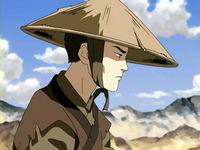
Zuko wore a conical straw hat when he hid in the Earth Kingdom.
Peasants and farmers tend to wear conical straw hats, developed to keep shade as large in area as possible, thus being practical for working in the sun. Thicker hats made from faux fur are sold in Kaya's town; one cap has a decorative striped raccoon tail attached to the back, and as such, it is mainly intended for use as an ornamental accessory.[47] The upper class of the Earth Kingdom mainly wear coronets known as guan; these vary in style immensely and indicate social rank and wealth.[35][38] Chin the Great wore an especially elaborate piece called the tongtian guan.[48] Mayor Tong wore a fangjin,[48] a rectangular hat for lower officials, while Pu-on Tim wore a putou, a rounded black hat used by scholars. The festival robes for male citizens of Chin Village include wushamao, large hats with two oval flaps protruding from the sides.[49] The women of Ba Sing Se wrap their hair around elaborate supports and ornament them with flowers.
Ornaments[]
Select citizens wear glasses, such as Earth King Kuei.[36] Some citizens also sport headpieces, mostly generals and military officials. Earth Kingdom necklaces can also be found worn by various people, often made of flowers, gold, jewels, or wood. Eloquent faux fur products, such as coats, scarves, and dead animal skins draped around the neck, are available at Kaya's town.[47]
Swimwear[]
As represented by Toph Beifong, Earth Kingdom swimwear resembles regular Earth Kingdom clothes in color, coming in yellows and browns.[26][50]
Tattoos[]
- Main article: Body markings in the World of Avatar
Tattoos are not common, nor frowned upon in the Earth Kingdom. Earth Kingdom citizens such as June[51] and The Boulder[38] have tattoos.
Fire Nation[]
Most fashions in the Fire Nation are colored red and accented with black, though colors ranging from yellow, gold, gray, brown, and white are also present. Layers of variously colored clothing and even pieces of body armor are common elements, though there is a significant gap between rich and poor, and different social classes wear different clothes depending on their wealth and power. One style popular with young women is midriff revealing tops, and sandals are a common form of footwear.[3]
Commoners and peasants[]
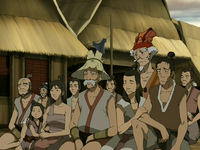
The people of Jang Hui wore many assorted styles.
Commoners and peasants tend to wear fairly simple clothing, but even within this strata, styles can vary significantly depending on physical location, specific economic status, and occupation of the wearer. In rural or poverty ridden areas, clothing tends to be more basic in design and not as brightly colored, as well as display more visible wear and tear. A prime example of this is the river village of Jang Hui, where many of the people earn their living by fishing and extreme poverty engulfed the town prior.[52] In more "cosmopolitan" areas, such as Fire Fountain City, clothing becomes more layered and elaborate and is typically kept in better condition. It is also typically colored in brighter shades of red, brown, and gold.[53]
There are also locations where clothing is the same for everyone, regardless of status or social importance. At the Boiling Rock prison, all prisoners wear uniforms of simple reddish-brown tops and bottoms.[29]
School uniforms[]
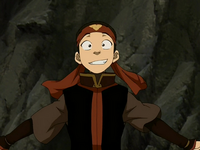
Aang wore a Fire Nation school uniform while using the alias of Kuzon.
Fire Nation schools follow strict uniform guidelines: the Fire Nation school that Aang joined had a uniform consisting of brown pants for boys and a brown skirt for girls, a shirt, a black and red vest, and a red sash marked with the school's logo. The school also had a policy against wearing head coverings indoors, though exceptions were allowed in certain circumstances.[54]
Swimwear[]
As with all Fire Nation clothing, the style is linked back to their native element and possibly decorated with the respective's nation's insignia. Two-piece bikinis are popular with female Fire Nation citizens, ranging in coloration from various shades of red to plain white with red details.[26]
Nobles[]
Nobility wear clothing similar to the Royal Family, with some exceptions. Mai's clothing, for example, is similar to a Vietnamese Ao Dai. Her outfit features a loose robe over wide pants allowing for increased mobility. Ty Lee's clothing also varies from the typical Fire Nation nobility to allow her to perform her acrobatic tricks. Ty Lee wears a short shirt similar to an Indian choli top that reveals her midriff and knee-length baggy pants covered with a split skirt.
Royalty[]
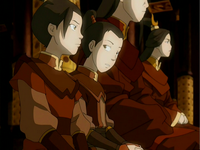
The Fire Nation Royal Family's clothes are similar to those of the Fire Lord.
The Fire Nation Royal Family is the richest and most powerful family in the Fire Nation. They wear the most elaborate clothing, which is usually a shade of red, and also sport royal armor.[3] However, in times of mourning, white formal clothing is worn, as white is the symbol of death in China.[55]
Prince and Princess[]
The clothing of the Prince and Princess of the Fire Nation is also elaborate. For military matters, such as war meetings and battles, the prince and princess don a formal armor that is black and deep red with gold trimmings, accentuated with gold flame ornaments in their hair top-knots. While not in public or a war meeting, the Fire Nation royals usually wear more comfortable robes.
Fire Lord[]
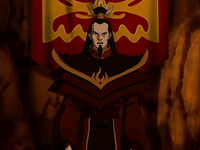
The Fire Lord sported an elaborate style of clothing.
The Fire Lord is the ruler of the Fire Nation. He wears an ornate robe as a sign of his power and rank. The shape of his robes is quite distinctive, with spiked shoulders akin to Thai theatrical costumes, which aids in making the Fire Lord look powerful and imposing. In addition to his unique robes, he also wears the Fire Lord headpiece, an ornament in the shape of the Fire Nation insignia.[3]
Phoenix King[]
When Ozai proclaimed himself the Phoenix King, he wore an elaborate helmet and armor. The helmet was gold and black, with a large jewel in the front. The armor Ozai wore was also decorative, resembling twin phoenixes with a cape that extended down to his feet.[50]
Top-knots[]
- Main article: Top-knot
Top-knots are the most frequently seen hairstyle in the Fire Nation, worn by both men and women of all classes. Citizens often wear decorative headpieces in their top-knots.[3] The top-knot is a sign of honor in the Fire Nation.
Accessories[]
Along with their clothing, Fire Nation citizens also wear many accessories. Royalty and nobility wear elaborate headpieces and golden necklaces, while the less well-off wear headbands and less elaborate headpieces. There are also head-crafts available in the Fire Nation, different from the ones in the Earth Kingdom in the sense that they are mostly gold in color.[3]
Cosmetics[]
In the Fire Nation, cosmetics appear to be a luxury, as only royalty and nobility have been seen wearing it. Azula's cosmetics and lipstick have more of a reddish color.
Necklaces[]
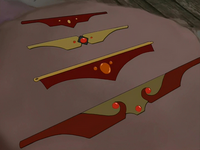
Fire Nation necklaces generally consist of simple bands adorned by beads.
Red and gold necklaces are common among women and men of the Fire Nation. Both Azula and Ty Lee wore necklaces to Chan's party,[26] and Suki and Katara also donned Fire Nation styled necklaces while masquerading as Fire Nation citizens.
Headpieces[]
- Main article: Headpiece
Headpieces are worn by many people in the world to adorn their otherwise bare top-knots. These headpieces range from the humble headpieces worn by normal citizens to the golden five-pronged headpiece worn by the Fire Lord, which resembles ancient Chinese fashion.
Fire Nation citizens often wear decorative headpieces in their top-knots. The headpieces are only decorative, however, and are in no way a rank of royalty. Zuko and Azula have both sported three-pronged headpieces in the traditional flame shape. While in the Earth Kingdom, however, Azula wore a simple red headpiece, but later replaced it with a golden one upon returning home.
Crown Prince headpiece[]
- Main article: Crown Prince headpiece
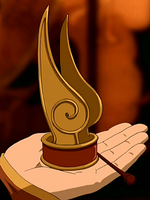
The Crown Prince headpiece is a flame motif.
The Crown Prince headpiece is an ancient royal artifact of the Fire Nation, meant to be worn by Heir to the Fire Lord, who can be male or female. The crown has two prongs, as opposed to the five pronged headpiece of the Fire Lord. The headpiece is crafted into the shape of the Fire Nation insignia. The headpiece was passed down from generation to generation, until it was inherited by Prince Sozin, who gave it to his friend, Avatar Roku. Roku kept it and wore it for the rest of his life. Years later, it was shown to be kept by Iroh, who passed it on to Zuko.[56] It is worn by placing it around the topknot, and it is held by a hairpin.
Fire Lord headpiece[]
- Main article: Fire Lord headpiece
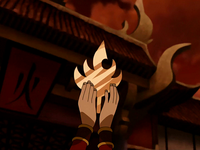
The Fire Lord headpiece, like the Crown Prince headpiece, is also a flame motif.
The Fire Lord's headpiece is an ancient royal artifact of the Fire Nation, meant to be worn by the Fire Lord, the absolute ruler of the nation. The headpiece is shaped like the Fire Nation insignia, except it possesses two additional prongs to make it appear like a crown. It is worn in a top-knot. The royal headpiece has been passed down for many generations of the nation's history from each Fire Lord to the next. The Fire Sages initiate the crowning ceremony.[55] The crown has been worn by at least eight Fire Lords: Zoryu,[57] Sozin's grandfather, Sozin's father, Sozin, Azulon, Ozai, Zuko, and Izumi.[56]
United Republic of Nations[]
As the United Republic of Nations and Republic City, its capital, grew, fashion shifted from the traditional clothing of the four nations to a trend that reflects modernity and the cosmopolitan nature of the new nation.
Accessories[]
Both sexes wear a variety of hats and gloves, and scarves are often worn, such as Mako's trademark red scarf, which belonged to his dead father. Asami once bought him a new one, noticing that his was old and frayed, although the young firebender refused to wear it. Hiroshi Sato is seen with a pocket watch that contains a family picture taken before his wife's murder. Bracelets are worn by more wealthy members of Republic City such as Shady Shin. Necklaces are also worn by various people in Republic City.
Cosmetics[]
Makeup seems to be worn mostly by wealthy associates such as Asami Sato. There are various colors of lipstick, from Asami's dark red to Lin Beifong's light pink shade, and eye shadow and makeup powder are also available.
Hair dye products have become more popular in the United Republic, with some citizens strongly bleaching their hair, or dyeing their hair unnatural colors. This trend appears to have started after new advances in hair dyes, such as Varrick Global Industries's "Varri-dye".[58]
Equalists[]
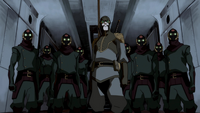
The Equalists' uniforms were mostly black.
Unlike most other citizens of the United Republic of Nations, the outfits of the Equalists take on more of an industrial appearance. Nearly all members of the Equalists wear outfits that completely cover their bodies, albeit allowing for unencumbered movement while performing chi-blocking. In addition, they all wear black gas masks with the Equalist insignia, red neck gaiters, and their iconic weapon, the electrified glove. Members of the Equalists who were not chi-blockers yet or were under the guise of being a civilian wore neck gaiters that covered their mouth and nose, and during the Attack on the Pro-bending Arena, the Equalists in the audience also wore a black hood to further conceal their identity. The Lieutenant's outfit differs in that he wears shoulder pads, his mask only partially covers his face, revealing his mouth and distinctive mustache, and he wears brass goggles instead of a gas mask. He also carries an energy pack on his back with his trademark weapon, his electrified kali sticks. Their leader, Amon, wore a sleeveless gray trench coat with ornate shoulder pads, a black shirt and arm braces, ornate gaiters over his footwear, and the most distinctive aspects of his attire, his hood and distinctive mask. Introduced later in the revolution, Equalist airmen wear a leather skull cap with goggles to protect their eyes. Their uniform consists of a light gray shirt and gray pants, their footwear being a durable pilot's boot. They also have a parachute on their back at all times in case of being shot down.
Factory workers[]
The only seen factory workers were the laborers at Future Industries. Their outfits consist of a green shirt with a brown vest and brown pants. They wear white knee-breeches over brown shoes. Their final piece of clothing is a green hat with a yellow ring around the outside.
Formal wear[]
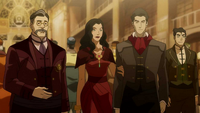
Hiroshi, Asami, Mako, and Bolin all wearing different styles of common Republic City formal wear.
Like everyday wear, men wear suits, although generally of a more elegant style than usual. Formal wear consists of either two-piece or three-piece suits, with the two-piece suits featuring a cummerbund or belt and either variety having a tangzhuang or a dress-shirt which is usually white, with ornate fastenings, such as knot buttons, and a mandarin collar. Cravats, neckties or scarves are worn, and trousers are always worn with knee-breeches and shoes. Women wear different varieties of ball gown, and hair is worn in varied styles. For both men and women, color and variation depend on the wearer's taste and heritage: for instance, perhaps reflecting his Water Tribe heritage, Tarrlok wore a sporran-like garment at his gala, while Korra's ball gown was sleeveless, and she covered her ponytail with a cap that matched her trademark armlet, and Mako and Bolin wore red and green respectively.
Men's fashion[]
Male citizens of the United Republic often wear outfits closely resembling either a changshan or a tangzhuang, incorporating a jacket or longer coat with a wide variety of lapels, a shirt with a mandarin collar, and trousers, tucked into knee-high boots, as sported by Amon, as well as commanders in the United Forces, such as General Iroh and Commander Bumi. Another fashion is to wear knee-breeches over black shoes, such as those worn by Mako, Bolin, Yakone, and Tarrlok. These were available in various colors and styles, with the jackets of wealthier people, such as Hiroshi Sato and Tarrlok, featuring a round pattern on the shoulders. Waistcoats are also worn on occasion. Capes or duster-type jackets are seen being worn by Water Tribe members such as Yakone and Varrick. Hiroshi Sato wore a brown leather jacket during a speech to Equalist supporters in Republic City Park and while he observed his new weapons destroying the fleet of the United Forces' First Division. Men's hairstyles range in style, from normal short hair to having a swirling ribbon of hair hanging in the front like Tahno. Men with longer hair are rare, but those that do usually have it in a ponytail or other various styles.
Pro-benders[]
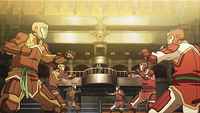
Pro-bending attire varies in color depending on the team playing, but maintains the same design.
Athletes in the sport of pro-bending wear clothing that protects them from hard hits, but is stylish as well. The uniform appears to be made of a cloth that is durable enough to take direct hits from the three playable elements. The footwear appears to be thin and lightweight, allowing increased agility. The helmet is made of a durable material to protect a player's head. It has a glass face mask to allow protection from debris during a match. However, only waterbending players can aim for the head, and any other element bent at the head is illegal.
Swimwear[]
Men wear one-piece bathing costumes, a close-fitting waterproof garment that covers the entire body from the torso to the upper thighs, leaving the arms and legs bare, and decorated with broad black and white stripes. Women wear one or two-piece bathing suits.[59]
United Forces[]
While nonbending soldiers in the United Forces wear gray, the benders of the army wear differently colored uniforms depending on their bending ability: firebenders wear maroon, earthbenders green, and waterbenders blue. High-ranking officers don a more elaborate uniform consisting of a belted red jacket, baggy white trousers, and tall black boots. This uniform is the same for all officers, regardless of any or no bending abilities.
United Republic Council[]
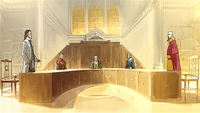
The United Republic Council wore formal attire that reflected their position.
The five members of the United Republic Council wore expensive clothing to indicate their prestige and dressed in the colors of the nation they represent. They all wore a badge bearing the insignia of the United Republic of Nations, indicating their position on the council.
Women's fashion[]
Women and men dress rather similarly in the United Republic, sporting jackets similar to men, but often wear a dress with tights and leather stockings. Women will opt to wear more fancy dresses on more formal occasions. Additionally, women will tend to wear long overcoats in cold weather, such as those sported by Asami and Lin Beifong in the South Pole.
Women's hair is usually kept long and styled in a variety of ways; ponytails, braids, and other up-dos are common. Bobbed haircuts, however, are not unknown, as the captain of the Red Sands Rabaroos and the White Falls Wolfbats fangirls have donned them. A recent development has been the invention of hair dye by Varrick, leading to one of his employees, the actress and showgirl, Ginger, dying her hair a unique shade of red. Although the product was not yet on the market, Varrick anticipated that sales would escalate once Ginger was seen using the product in his weekly serial The Adventures of Nuktuk: Hero of the South.[58]
Miscellaneous[]
Theater and film[]
Actors and entertainers in the Avatar world would often make use of distinctive costumes in their shows, like in the theater or in the movers. A key aspect of costumes in the entertainment industry is their comical and exaggerated appearance; for instance, the actors of Unalaq and Ozai were dressed in over-the-top parodies of the ordinary clothing of the people they were imitating, causing them to closely resemble pantomime villains. Sometimes these costumes are also sexualized to appeal to the crowd - for example, the costume for Katara's actor was low-cut and had a split skirt, revealing the actress's bare legs.[60] Similarly, both Ginger and Bolin wore costumes that showed off their bodies, baring far more skin than would be comfortable in the climate of the South Pole.[61]
Traditional theater employed many stagehands to move in the background, rearranging scenes or otherwise adding to the theatrics. To minimize the attention drawn to them, they dressed entirely in black.
The use of masks and face-paint was also prevalent in many performances; the popular tragedy Love amongst the Dragons, which had spirits among its characters, employed masks to make the actors resemble their supernatural roles better. Likewise, in The Boy in the Iceberg, makeup is used to a great extent to enhance the facial expressions of the characters, making them visible for every spectator in the theater.
Trivia[]
- Clothing in the Avatar World is influenced by several real-life cultures, such as Chinese, Vietnamese, Thai, Korean, Japanese, Native American, and Indian culture.
- The fashion of the Air Nomads closely resembles that of Tibetan Monks.
- The fashion in Republic City is reminiscent of Chinese styles found in the early 20th century, especially from Shanghai, while incorporating extra articles of clothing to resemble western fashion, rather than some Asian styles and fashions of earlier dynasties in China that is observed in the other kingdoms in Avatar: The Last Airbender. With the exception to some attire such as fedora hats, pea coats, neckties, and the white 'stockings' often worn by Republic City dwellers are similar to the knee-breeches used in Europe from the late 16th century up to the early 19th century.
- The attire of the Ba Sing Se aristocracy is similar to the Manchurian-Chinese qipao, especially the clothing worn during parties and important public events. However, the attire worn in Gaoling has different influences, with Toph's fancy dress modeled after Tang-dynasty clothing;[62] Toph and Poppy Beifong are seen dressed in traditional robes called hanfu, also seen in many Fire Nation styles.
- Ursa's wedding dress was based on the styles of old-era Korean nobility.[63]
- Song and her mother wore clothing derived from a traditional Korean garment known as a hanbok.[27]
- Female hairdos in the Upper Ring of Ba Sing Se are reminiscent of wealthy women during China's Qing Dynasty. Women wrap their hair similar to the fashion of the Manchu Qing Dynasty of China.
- The Earth King's attire is based on real Chinese Manchurian emperors of the Qing Dynasty.
- Many hats, headdresses, and headgears found in the Fire Nation and Earth Kingdom are similar to topknot-held headpieces known as "guan".
- Pro-bending uniforms were based on early football equipment and uniforms according to the creators in Korra: Making of a Legend.[64]
- The design of the gloves used by many members of the Water Tribe was inspired by the real world split mittens that are commonly used in snowboarding.[65]